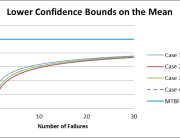Many “design for reliability” based activities essentially consist of a process that forces engineers to implement sound design principles. More specifically, it requires designers to consider the entire spectrum of potential use conditions (e.g., environments, loading, storage, etc.) and appropriately addresses the relevant factors in the product’s or system’s design. This typically includes Materials Selection considerations based on environmental conditions (e.g., heat, corrosivity) and the potential failure mechanisms (e.g., fatigue, wear) of the product’s application. Reliability Physics/Physics-of-failure Analysis is a popular technique for considering the physics behind a component’s root causes of failure, and estimating its likelihood of occurrence.These types of decisions generally are the basis for subsequent Parts Selection and Application decisions that ultimately dictate the longevity of the system. In some cases, Counterfeit Parts Solutions may be needed to ensure that the components that make their way into the system are, in fact, of the reliability and quality of their design; particularly when utilizing Commercial Off the Shelf (COTS) items. If a system remains operational over an extended period of time, Component Obsolescence Planning may be necessary if spares for a particular part that requires replacement become unavailable.
In addition to components, reliability is also designed into the system through the implementation of similar predictive-based analyses. Component failures are ultimately responsible for eventual systems failures. Accordingly, known and/or observed component failure modes must be considered from an overall system perspective in order to identify the potential causes of a complete system failure. System-level analyses, such as a Failure Modes Effects and Criticality Analysis or a Fault Tree Analysis, are useful approaches to determine the effects of lower-level component failures on higher level assemblies and the entire system. These and other Reliability Modeling techniques help to identify critical components (e.g., linch pins) and to prevent or reduce the susceptibility to single point of failure assemblies, through the subsequent introduction of redundancy or other failure mitigating measures into the system’s design. Considering and/or anticipating possible mechanisms of failure during a product’s design helps to avoid costly oversights and produces a design that is more capable of withstanding the operational stressors that precipitate failures.



